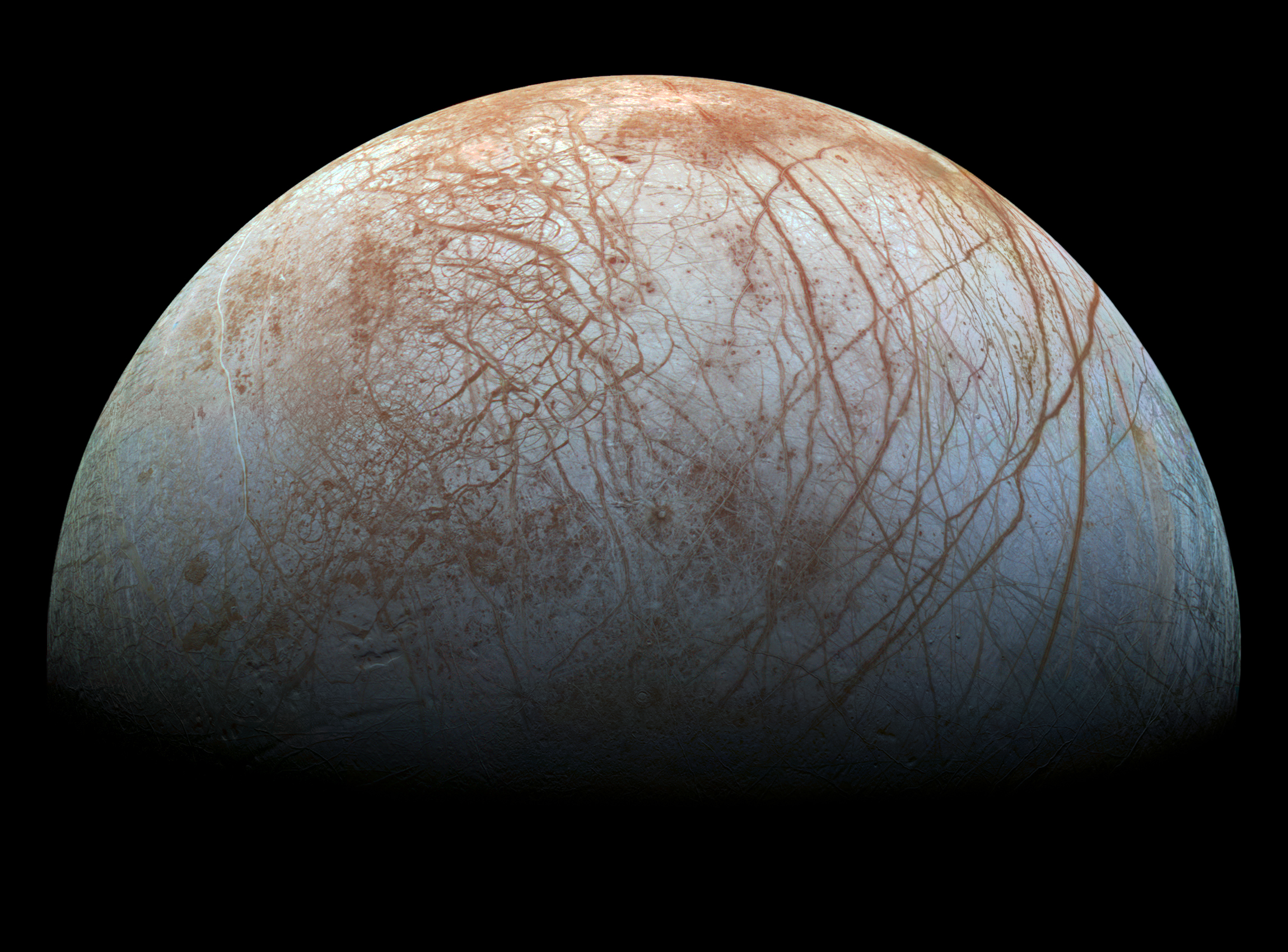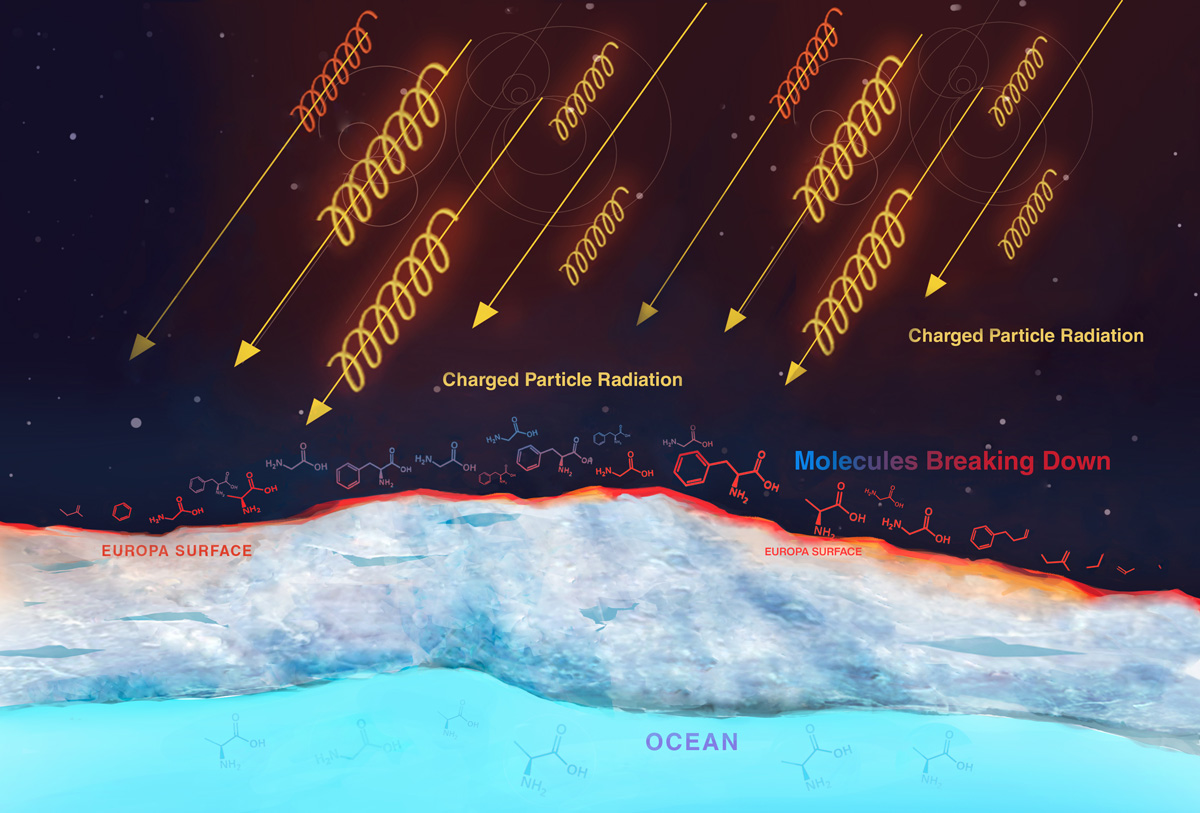Life is abundant on Earth, but we haven’t yet found it anywhere else in the universe. How do we search for life beyond our home planet? Scientists say we should look for three key ingredients that make life possible: liquid water, chemistry, and energy. Also, life takes time to develop. We should look for life on worlds where sufficient time has passed for life to get started.
Jupiter’s icy moon Europa may have these essential ingredients and is as old as Earth. NASA is sending the Europa Clipper spacecraft to conduct a detailed exploration of Europa and investigate whether the icy moon, with its subsurface ocean, has the capability to support life. Understanding Europa’s habitability will help scientists better understand the potential for finding life beyond our planet and guide us in our search.
Water
Liquid water tops the list of ingredients for life, and Europa has lots of it. Scientists think Europa has a salty ocean beneath its icy crust with about twice as much water than all of Earth's oceans combined. Water dissolves nutrients for organisms to eat, transports important chemicals within living cells, supports metabolism, and allows those cells to get rid of waste. Scientists are confident there's a rocky seafloor at the bottom of Europa’s ocean. Hydrothermal activity could possibly supply chemical nutrients that could support living organisms.

The best evidence that there's an ocean at Europa was gathered by NASA's Galileo spacecraft, which orbited Jupiter from 1995 to 2003. While Europa has no magnetic field of its own, when the Galileo spacecraft made 12 close flybys of Europa, its magnetometer detected a magnetic field within Europa as Jupiter's powerful magnetic field swept past the moon. Scientists think the most likely cause of this magnetic signature is a global ocean of salty water.
Europa's bright, icy surface is unlike anything seen on Earth. It’s the smoothest body in the solar system, with few towering mountains or deep basins. Ridges and grooves crisscross the surface, breaking up the landscape. Many of these features coincide with long, curving streaks that are dark and reddish in color – some stretching across the surface in great arcs over 600 miles (1,000 kilometers) long. Elsewhere, domes, pits, and jumbles of icy blocks hint that warm ice may be rising from deep below.
Europa's surface has signs there may be an ocean beneath it. Images of Europa’s surface show patterns of cracks and ridges that suggest a global ocean allowing for large tides that deform the surface. The largest two impact structures on Europa show concentric patterns, which suggests impacts that may have penetrated through Europa’s ice shell into liquid water. In addition, Europa’s surface geology suggests that warm ice has risen upward through the ice shell, likely from near an ice-ocean interface.
Models also suggest that Europa's icy shell gets stretched and released by the tug of Jupiter's gravity as Europa orbits the giant planet. This squeezing in and out is called tidal flexing, and it creates heat inside Europa. In fact, the tidal flexing is likely creating enough heat inside Europa to maintain the liquid ocean beneath the surface.
ChemistryChemistry
Along with water, life as we know it also needs certain chemical elements – the building blocks of life – including carbon, hydrogen, nitrogen, oxygen, phosphorus, and sulfur. These elements are common in the universe and make up 98% of living matter on Earth by combining to form organic molecules essential to life. Scientists think these elements were likely incorporated into Europa as the moon formed. Later, asteroids and comets collided with the moon and may have left more organic materials.
All life on Earth is built from organic molecules, but simply finding organic molecules does not mean these molecules are linked to life. The molecules also can be made in lots of ways that do not involve living organisms. However, finding these types of molecules on Europa would help scientists determine if the ingredients for life have ever existed on the icy moon.
Some of these essential chemical elements may be located within Europa’s icy shell today. Other essential chemical elements may originate from Europa’s core and the weathering of the moon’s rocky interior. Tidal flexing is a heating system that can cycle water and nutrients among the moon's rocky interior, ice shell, and ocean. This could create a watery environment rich with chemistry conducive to life.
EnergyEnergy
The third ingredient for life is energy. All lifeforms need energy to survive. On Earth, most of that energy comes from the Sun. For example, plants grow and thrive through photosynthesis, a process that converts sunlight into energy. The energy is transferred to humans, animals, and other organisms when the plants are eaten.
But the type of life that might inhabit Europa likely would be powered purely by chemical reactions instead of by photosynthesis, because any life at Europa would exist beneath the ice, where there is no sunlight.

Europa's surface is blasted by radiation from Jupiter. That's a bad thing for life on the surface – it couldn't survive. But the radiation may create fuel for life in an ocean below the surface.
The radiation splits apart water molecules (H2O, made of oxygen and hydrogen) in Europa's extremely tenuous atmosphere. The hydrogen floats away and much of the oxygen stays behind and may bind to other elements. Oxygen is a very reactive element, which means it could potentially be used in chemical reactions that release energy. If the oxygen somehow makes its way to the ocean, it could react with other chemicals to possibly provide chemical energy for microbial life.
Europa’s ocean is also probably in direct contact with warm rock at the seafloor. As Europa revolves around the gas giant, the icy moon’s interior flexes. The flexing forces energy into the moon’s interior, which then seeps out as heat (think of how repeatedly bending a paperclip generates heat). The more the moon’s interior flexes, the more heat is generated.
The interaction with warm rock could supply hydrogen and other chemicals to the ocean. While the energy input for life on Earth comes primarily from the Sun, Europa’s energy input might come from surface chemistry and water-rock interactions on the seafloor.
Also, if Europa’s rocky ocean floor is heated by tidal flexing, that process could potentially be supplying energy in the form of available chemical nutrients in hydrothermal vents. We know this type of process is possible because we see something similar in hydrothermal vents here on Earth. Vents on Earth were first discovered in 1977 on the Galapagos Rift, an area deep in the Pacific Ocean, far from the coast of South America. Since then, many such vent systems have been found on Earth’s ocean floors. The discovery revolutionized our understanding of life on Earth and is considered one of the most important discoveries ever made in ocean science.


